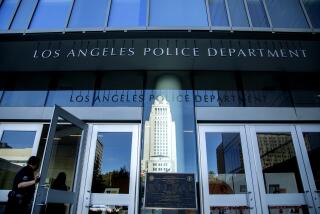Tracking Down Crime Statistics to Stay Out of Harm’s Way
- Share via
How safe are you from crime?
Federal, state and local law enforcement Web sites offer plenty of information to help people answer that question. But be careful. So much information is available that it’s easy to get overwhelmed and confused.
The Federal Bureau of Investigation offers extensive crime information on its site at https://www.fbi.gov/ucr/ucr.htm. The FBI’s Uniform Crime Reports are assembled from violent and major property crimes reported by local police departments across the country. Only crimes reported to police are included, and not all departments participate.
Data is available in PDF and Microsoft Excel formats. It’s not the best for casual Web surfing, but it’s very handy for users who want to use the data for a report or class project.
Because local departments typically send their data to the FBI just once a year, this isn’t a good source of up-to-the-minute information. Still, the FBI’s data provide an excellent resource for getting information about crime trends in major cities or around the nation.
The Bureau of Justice Statistics conducts the annual National Crime Victimization Survey and posts the results at https://www.ojp.usdoj.gov/bjs/cvict.htm. A summary of the bureau’s data is available at https://www.ojp.usdoj.gov/bjs/glance.htm.
The results differ from the FBI’s reports because they are based on interviews of more than 50,000 people across the country, rather than formal police reports.
The idea is to get a broader picture of crime, not just crimes reported to police. However, since the survey is primarily national, local data are available for only 12 metro areas. Los Angeles is one of the 12.
For local county and city information, go to the California attorney general’s site at https://caag.state.ca.us/cjsc. Navigating this site can be tricky, though.
Click on Statistics to start. Then click through to county and city crime reports. That brings up a somewhat confusing page that describes the data tables available and provides links to the information.
Again, these numbers are based on incidents reported to police. But in many cases they provide much better local detail than the information available from the FBI site.
Users should remember, though, that a large number of incidents in an area doesn’t automatically mean the area is unsafe. A high number of incidents might just reflect a large population, said James W. Meeker, professor of criminology at UC Irvine.
“For example, you can have a place like the Irvine Spectrum, where you have lots of people,” Meeker said. “If all of a sudden you see a hot spot of robbery taking place there, people might think, ‘Aw, I don’t want to go to the Spectrum because I’m likely to get robbed.’ But if you actually look at the robberies per thousands of people that go through, you might be safer there than you are in your own home.”
Another option for getting a sense of the crime level in specific neighborhoods is APBNews’ Neighborhood CrimeCheck, at https://www.apbnews.com/resourcecenter/datacenter.
Enter a ZIP Code to get a violent-crime risk score. Scores range from one (low risk) to 10 (watch your back).
APBNews’ scores are not based solely on incident reports. They also consider 21 neighborhood variables, including economics, that have proved to be indicators of violent crime.
*
Robert Niles is a producer for Latimes.com.


